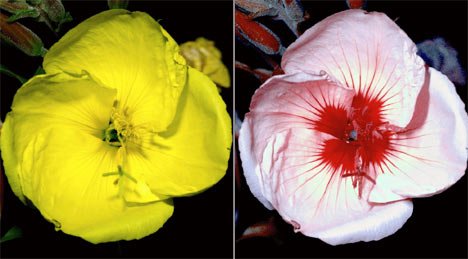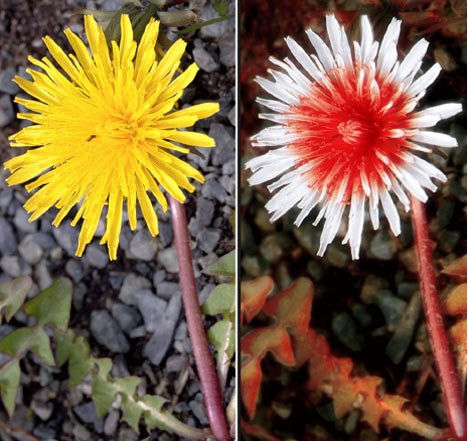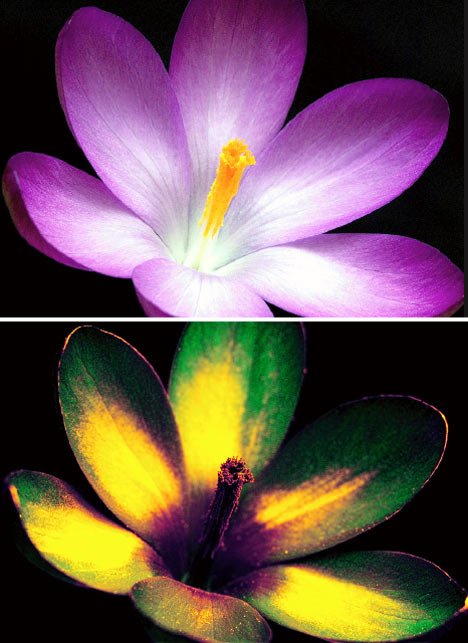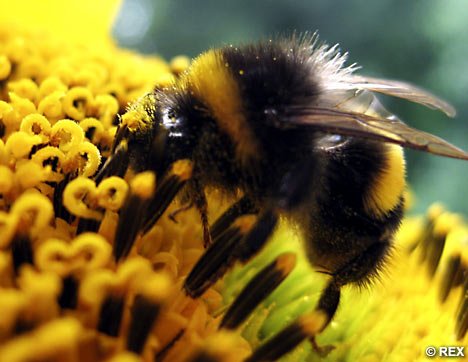'Abd-al Latif
CagePrisoners.com
- Messages
- 3,680
- Reaction score
- 922
- Gender
- Male
- Religion
- Islam
:salamext:
وَأَوۡحَىٰ رَبُّكَ إِلَى ٱلنَّحۡلِ أَنِ ٱتَّخِذِى مِنَ ٱلۡجِبَالِ بُيُوتً۬ا وَمِنَ ٱلشَّجَرِ وَمِمَّا يَعۡرِشُونَ (٦٨) ثُمَّ كُلِى مِن كُلِّ ٱلثَّمَرَٲتِ فَٱسۡلُكِى سُبُلَ رَبِّكِ ذُلُلاً۬*ۚ يَخۡرُجُ مِنۢ بُطُونِهَا شَرَابٌ۬ مُّخۡتَلِفٌ أَلۡوَٲنُهُ ۥ فِيهِ شِفَآءٌ۬ لِّلنَّاسِ*ۗ إِنَّ فِى ذَٲلِكَ لَأَيَةً۬ لِّقَوۡمٍ۬ يَتَفَكَّرُونَ (٦٩)
And your Lord inspired the bees, saying: "Take you habitations in the mountains and in the trees and in what they erect. "Then, eat of all fruits, and follow the ways of your Lord made easy (for you)." There comes forth from their bellies, a drink of varying colour wherein is healing for men. Verily, in this is indeed a sign for people who think. (Quran, The Bee 16:68-69)
To the human eye, a garden in bloom is a riot of colour. Flowers jostle for our attention, utilising just about every colour of the rainbow.
But of course, it is not our attention they need to attract, but that of insects, the perfect pollinating agents.
And as these remarkable pictures show, there is more to many flowers than meets the eye - the human eye at least. Many species, including bees, can see a broader spectrum of light than we can, opening up a whole new world.
The images, taken by Norwegian scientist-cameraman Bjorn Roslett, present a series of flowers in both natural and ultraviolet light, revealing an insect's eye view.
Scroll down for more

Evening primrose (Oenothera biennis): To the human eye the flower looks solid yellow but insects can aim for the bullseye in the centre

Dandelion (Taraxacum officinale): The familiar mop top is transformed for the bees
Ultraviolet light, invisible to us, uncovers colours and patterns which drawthem to the source of pollen and nectar - all hidden to humans without special equipment.
This secret colour world was discovered in the Fifties and scientists realised that these distinct patterns were designed to act as "landing strips" or arrows, guiding the insects to the right spot.
Because we cannot see UV light, the colours in these photographs are representational, but the patterns are real.
Scroll down for more

Wood anemone (Anemone nemorosa): Insects are often drawn to darker colours, so this vibrant hue would be instantly attractive and draw them in

Spring crocus (Crocus vernus): The ultraviolet image creates three rings of colour to guide insects to a happy landing

Silverweed (Potentilla anserina): It is hard to imagine that these yellow flowers are actually hiding a two-tone pattern, as revealed in the ultraviolet image

Many species, including bees, can see a broader spectrum of light than we can
http://www.dailymail.co.uk/sciencet...-view-How-insects-flowers-differently-us.html
وَأَوۡحَىٰ رَبُّكَ إِلَى ٱلنَّحۡلِ أَنِ ٱتَّخِذِى مِنَ ٱلۡجِبَالِ بُيُوتً۬ا وَمِنَ ٱلشَّجَرِ وَمِمَّا يَعۡرِشُونَ (٦٨) ثُمَّ كُلِى مِن كُلِّ ٱلثَّمَرَٲتِ فَٱسۡلُكِى سُبُلَ رَبِّكِ ذُلُلاً۬*ۚ يَخۡرُجُ مِنۢ بُطُونِهَا شَرَابٌ۬ مُّخۡتَلِفٌ أَلۡوَٲنُهُ ۥ فِيهِ شِفَآءٌ۬ لِّلنَّاسِ*ۗ إِنَّ فِى ذَٲلِكَ لَأَيَةً۬ لِّقَوۡمٍ۬ يَتَفَكَّرُونَ (٦٩)
And your Lord inspired the bees, saying: "Take you habitations in the mountains and in the trees and in what they erect. "Then, eat of all fruits, and follow the ways of your Lord made easy (for you)." There comes forth from their bellies, a drink of varying colour wherein is healing for men. Verily, in this is indeed a sign for people who think. (Quran, The Bee 16:68-69)
A bees-eye view: How insects see flowers very differently to us
To the human eye, a garden in bloom is a riot of colour. Flowers jostle for our attention, utilising just about every colour of the rainbow.
But of course, it is not our attention they need to attract, but that of insects, the perfect pollinating agents.
And as these remarkable pictures show, there is more to many flowers than meets the eye - the human eye at least. Many species, including bees, can see a broader spectrum of light than we can, opening up a whole new world.
The images, taken by Norwegian scientist-cameraman Bjorn Roslett, present a series of flowers in both natural and ultraviolet light, revealing an insect's eye view.
Scroll down for more

Evening primrose (Oenothera biennis): To the human eye the flower looks solid yellow but insects can aim for the bullseye in the centre

Dandelion (Taraxacum officinale): The familiar mop top is transformed for the bees
Ultraviolet light, invisible to us, uncovers colours and patterns which drawthem to the source of pollen and nectar - all hidden to humans without special equipment.
This secret colour world was discovered in the Fifties and scientists realised that these distinct patterns were designed to act as "landing strips" or arrows, guiding the insects to the right spot.
Because we cannot see UV light, the colours in these photographs are representational, but the patterns are real.
Scroll down for more

Wood anemone (Anemone nemorosa): Insects are often drawn to darker colours, so this vibrant hue would be instantly attractive and draw them in

Spring crocus (Crocus vernus): The ultraviolet image creates three rings of colour to guide insects to a happy landing

Silverweed (Potentilla anserina): It is hard to imagine that these yellow flowers are actually hiding a two-tone pattern, as revealed in the ultraviolet image

Many species, including bees, can see a broader spectrum of light than we can
http://www.dailymail.co.uk/sciencet...-view-How-insects-flowers-differently-us.html
